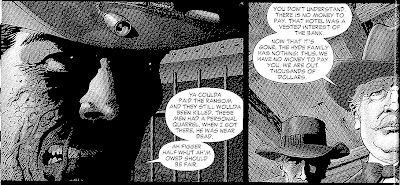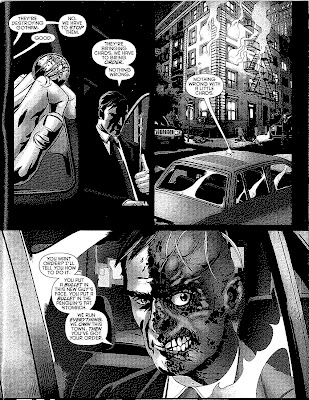
Ever wonder why people in comics aren't teleporting to work, watching TV through a personal projection device while walking down the street, or attending seminars hosted by an android via group-telepathy?
Instead, the worlds in our favorite comics still have potholes, poverty, and petroleum-powered cars. In fact, aside from the occasional reality-bending crisis involving metahumans, it’s hard to distinguish our world from theirs in terms of technological progress or standards of living. This begs the question of what happens to all the alien wreckage after the Justice League fends off another alien invasion, or to the abandoned spaceships when interplanetary thugs with a grudge against Superman land on Earth. Do men in black immediately cart them off to secret government facilities and weaponize them? If so, then these governments are doing a great disservice to their people. The fastest way to achieve economic growth is through the free and unfettered dissemination of knowledge. Governments should encourage the private sector to develop commercial uses for all the space junk that winds up on earth, thereby simultaneously increasing both the capital stock and total factor productivity.
Aside from physical capital, economies must take advantage of their human capital to grow. But even with metahumans this is a tricky proposition. In an earlier post Mark discussed the potential benefits of having mutants performing tasks such as construction if they ever took a break from blowing stuff up. However, looking at economic development through the lens of the Solow model I feel that these mutants may ultimately prove unable to increase long-run living standards. Any effect that Magneto may have on productivity will only temporarily move the economy to a higher steady-state output per person (y/n). With his death the economy will move back to where it was (and probably experience some unpleasant distortions during the transition). The reason is that Magneto is essentially no different than a tractor or any other piece of capital equipment. He ages, depreciates and eventually dies. More importantly however, is the basic result of the Solow model: sustained growth in y/n can only be achieved if there is concurrent growth in our stock of knowledge and technology, something Magneto cannot contribute to. Without technological change, the economy will eventually reach a steady-state level of y/n and all growth will cease. Even so, the Marvel universe does have one ace in the hole, and he’s got a big green head!
Samuel Sterns was just an average Joe working at a chemical plant when he was exposed to massive amounts of gamma radiation. Thus was born The Leader, a villain whose only real power is superhuman intellect (maybe some telekinesis, but whatever). This guy probably has enough ideas in his head to keep scientists busy for millennia. Imagine the technological advancements that could be made if the government hooked him up with a research position! And if there’s one Leader, then it’s possible to have more metahumans with precariously large crania. Given the right incentives, maybe some of these bums turned mutant geniuses will come up with life-enhancing inventions like 3D holographs or a flying car. There should be grants and subsidies to promote their research activities and encourage investment into new technologies, so guys with green skin and giant brains can yell at MIT grad students instead of toppling civilization with armies of plastic humanoids.
Finally, aside from investment from within our planet, economic growth can be sped along by Foreign Direct Investment (FDI) inflows from other civilizations. But what’s surprising is that with an entire galaxy of highly advanced civilizations, no interplanetary investment seems to be reaching earth. Capital should flow to where its return is highest. Being mere humans in a giant multiverse of galactic powers, it’s a fair assumption that earth is an LDP (less developed planet) with a comparatively small capital stock. According to the Solow model, alien entrepreneurs should be jumping at the opportunity to invest in Earth. Add a growing stock of technology from metahumans and falling debris and you can get productivity and standards of living rising indefinitely. The only thing I can think of that deters aliens from investing is the unstable sociopolitical climate. I mean, who really wants to deal with the risks of a Luthor presidency or an Emperor Joker? It seems that now, more than ever, the earth needs superheroes to stamp out crime so that other planets might feel safer about their investments.
Even without additional capital inflows, all people on comic book earth have a real shot at modernizing if the proper steps are taken. And it’s not just the responsibility of the governments, but also of the superheroes. The Green Lanterns have access to technology and information from all the planets in the galaxy. Superman can travel through space and time almost instantaneously and in fact spends much of that time in the 31st century with the League of Superheroes. It’s about time some of this technology makes it back to Earth.
After all, maybe one of those alien spaceships had a toilet that could conserve water more efficiently, or something. It can’t all be hyperdrive this and giant laser cannon that!





 On this island, mutants were enslaved and forced to work for the government. This turned the troubled economy of Genosha around in the span of a few years, making it a thriving paradise (for those who were not enslaved and constantly tortured, of course). Naturally this brutal treatment of mutants could not stand and the X-Men destabilized the government (resulting in thousands of deaths, but that is the price of freedom and giant, bloody splash pages). Eventually Genosha became a haven for mutants. And with an all mutant population, the island did thrive, but in total isolation from the rest of the world.
On this island, mutants were enslaved and forced to work for the government. This turned the troubled economy of Genosha around in the span of a few years, making it a thriving paradise (for those who were not enslaved and constantly tortured, of course). Naturally this brutal treatment of mutants could not stand and the X-Men destabilized the government (resulting in thousands of deaths, but that is the price of freedom and giant, bloody splash pages). Eventually Genosha became a haven for mutants. And with an all mutant population, the island did thrive, but in total isolation from the rest of the world.








